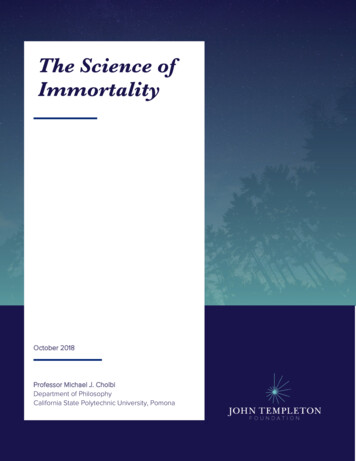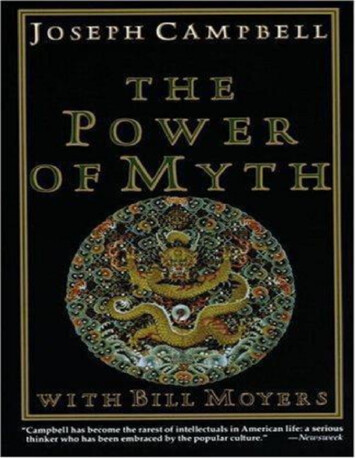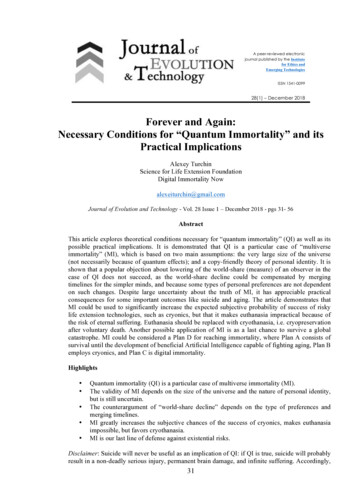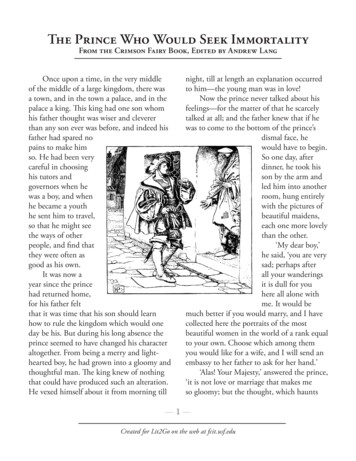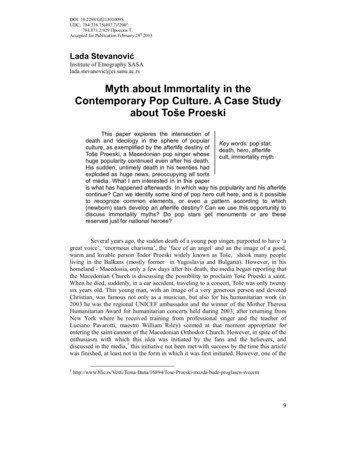
Transcription
DOI: 10.2298/GEI1301009SUDC: 784:316.75(497.7)"200"784.071.2:929 Проески Т.Accepted for Publication February 28th 2013Lada StevanovićInstitute of Etnography SASAlada.stevanovic@ei.sanu.ac.rsMyth about Immortality in theContemporary Pop Culture. A Case Studyabout Toše ProeskiThis paper explores the intersection ofdeath and ideology in the sphere of popularKey words: pop star,culture, as exemplified by the afterlife destiny ofdeath, hero, afterlifeToše Proeski, a Macedonian pop singer whosecult, immortality mythhuge popularity continued even after his death.His sudden, untimely death in his twenties hadexploded as huge news, preoccupying all sortsof media. What I am interested in in this paperis what has happened afterwards. In which way his popularity and his afterlifecontinue? Can we identify some kind of pop hero cult here, and is it possibleto recognize common elements, or even a pattern according to which(newborn) stars develop an afterlife destiny? Can we use this opportunity todiscuss immortality myths? Do pop stars get monuments or are thesereserved just for national heroes?Several years ago, the sudden death of a young pop singer, purported to have ‘agreat voice’, ‘enormous charisma’, the ‘face of an angel’ and an the image of a good,warm and lovable person Todor Proeski widely known as Toše, shook many peopleliving in the Balkans (mostly former in Yugoslavia and Bulgaria). However, in hishomeland - Macedonia, only a few days after his death, the media began reporting thatthe Macedonian Church is discussing the possibility to proclaim Toše Proeski a saint.When he died, suddenly, in a car accident, traveling to a concert, Toše was only twentysix years old. This young man, with an image of a very generous person and devotedChristian, was famous not only as a musician, but also for his humanitarian work (in2003 he was the regional UNICEF ambassador and the winner of the Mother TheresaHumanitarian Award for humanitarian concerts held during 2003, after returning fromNew York where he received training from professional singer and the teacher ofLuciano Pavarotti, maestro William Riley) seemed at that moment appropriate forentering the saint cannon of the Macedonian Orthodox Church. However, in spite of theenthusiasm with which this idea was initiated by the fans and the believers, anddiscussed in the media,1 this initiative not been met with success by the time this articlewas finished, at least not in the form in which it was first initiated. However, one of Proeski-mozda-bude-proglasen-svecem9
Гласник Етнографског института САНУ LXI (1) quick responses concerning the canonization of Toše Proeski was the answer of bishopPetar who said that “the Church has its own rules which are important when a person isproclaimed to be a saint. Usually initiative is not given immediately after someone’sdeath. It is necessary to have some time distance, to give concrete suggestions, to collectinformation about somebody’s work, and only after that comes the process of decision ifsomebody can become saint or not.” 2 According to this response, we may conclude thatit is still early for the Macedonian Orthodox Church to give the final decision. However,not much time has passed, only a year, when another initiative was fostered by theMother Theresa organization for giving Toše an aureole of the saint, in the House of thesisters of Mother Theresa, this time in Vatican. Namely, on the grounds of manyhumanitarian actions in which Toše Proeski took part, helping people regardless of faithand nation, the suggestion has been given in front of the pope in August 2012, and itmight happen that the Pope Benedictus XVI and the Orthodox Church start together theprocess of beatification. 3What I am interested to show in this paper is what is the destiny of a pop starsuch as Toše in his afterlife and is he, despite of the absence of canonization, anywaysome kind of a saint (the description that I gave about him in the beginning of the text,which is based on the impressions in the media, points to the conclusion that he isdefinitely idealized). Starting from the position that death, especially of public persons,represents an important domain for the production of dominant narratives, and thatmonuments of famous poets, politicians and scientists have a crucial role in the creationof collective memory and formation of cultural history and thus identity construction,what I am interested in is the way in which, and if at all, popular culture with itsprotagonists is also part of this process. Is it possible to claim that this process of“immortalization” is “spontaneous”, and is there (and if there is, to which extent)freedom in the creation of the afterlife cult (of any kind, not necessarily related to thechurch), who is the creator of such a cult, and for whom is it important.But let me start from the beginning of this story, of Toše Proeski’s sad end. Thefamous young singer died in a car accident on a Croatian highway on October 16th2007. During the next day his corpse was transported by a Macedonian army helicopter.Grieving citizens gathered at the Skopje airport and at the main city square, to give theirlast respects to the famous singer. Toše Proeski received from the state of Macedoniathe title of its honorable citizen.4 On the day after his death, on 17th October 2007, apublic funeral organized by the State was performed in his birthplace and hometownKruševo, with all the characteristics of one such ceremony including the presence of theMacedonian Army – the honor guard, military orchestra and honorary rifle salute. Thewhole ceremony was broadcasted by Macedonian television, witnessing the presence ofmany people including state officials (President Branko Crvenkovski, Prime MinisterNikola Gruevski), foreign ambassadors, other diplomats, as well as other musiciansfrom all over the region. The religious service was held by Archbishop Stephen ofOhrid5. The day of the funeral was pronounced a national grieving day. The media andinternet blogs, as well as web pages were overwhelmed by messages of grievance forToše’s too early departure. Many memorial web sites are still active, such as om/project.cfm?id 3498, 11.11.2012.5http://en.wikipedia.org/wiki/To%C5%A1e Proeski, 11.11.2012.310
Lada Stevanović, Myth abouth Immortality. memoriam fun club Toše6, with the following motto “We couldn’t keep you from death,but we’ll keep you from oblivion” (last change that I have noticed is November 2012),or Forever Toše Proeski with the motto “In order to keep the memory of him, and tokeep him forever in our hearts”7. I have also discovered an interesting webpage titledRespectance (share your memories). It is a free portal where people can give respect tothose they lost, in the first place people they love, regardless of their fame, confirmingthe old belief that in death, we are all the same and equal. On this portal, Toše with hisown tribute page, is in company with Curt Kobain, Michael Jackson, AlexanderSolzhenitsyn, Steve Jobs, Whitney Huston, Amy Winehouse and many others, lessrenowned, but still loved and missed people. So in the virtual sphere, the memory ofToše is still vividly preserved – trough the messages of love, of missing, referring tohow great a person he was, and through the sharing of his songs. These messages aresometimes very simple and laconic such as “come back”, sometimes they are moreelaborate - “Angel, I’ve learnt how to love, how to see good in people, and learnt howto live good. All Macedonia loves you and has shown that to you on the day when wegathered to cry together and to grieve for too early lost lucky star. I will keep forever inmy heart this big man. R &P.”8This message is interesting because it resembles traditional lamentation in theway of addressing the dead and the belief that he can receive the message in the worldbeyond.But let us concentrate for the moment on the website Respectance(www.respectance.org) to get the wider picture of the context in which the memories ofToše Proeski are kept. This website represents a type of memorial9 virtual space, wherethe hypertext creates some kind of contemporary virtual cemetery. First of all, like anygraveyard, it is open to everyone – those who are famous together with those who aregrieved only by their closest kin and friends, which is obvious from the mottos on thetitle page:“Everyone has memories to share.” “Keep them alive forever.”Basically, entering this site, we enter a huge place through which we may walk- virtually, like in a graveyard. This comparison seems to me important since graveyardsrepresent a public space where people not only mourn and say good bye to their deadbut also express their emotions (here I refer to tradition of lamentation extremelyimportant in the Balkan history all up to modern times, and still alive in a rural areas).So, this kind of website, exceeding the physical space of the graveyard, connects peoplewho grieve and people who are mourned in a new way. It also collects the data aboutsomeone’s life, so the visitors or the users of the site might (do not have to do itnecessarily) fulfill the following data adding this to the obligatory date and place ofbirth and death: career, childhood, education, family, passions, traveling. It is interestingthat anyone can give contribution to this site, making own tributes that other people mayjoin, so here in a way we can see that this site functions also like an obituary in a sensethat it may be personalized by anyone, with another hypertextual possibility – , 11.11. 2012.http://zauvijekproeski.blogger.ba/, 11.11. memorial/show/4qb117cpbbna9k9At this place I refer to definition of memorial given by James Young who emphasizes that memorialis anything that keeps memory of somebody – memorial places, memorial books etc (Young 2006:201).711
Гласник Етнографског института САНУ LXI (1) open not only to connect to the other texts, it stays open to inscriptions either insidealready created “tributes”, or creation of the new one. This is a very interestingsituation, completely in accordance with the spreading of the importance of IT culture inour lives and it will be interesting to see how much “virtual graveyards” will be presentin the future.But let us go to the physical reality and see the afterlife destiny of Toše inMacedonia. As it has already been mentioned in the beginning of this text, the issue ofbeatification of Toše Proeski has officially been raised in the Vatican, but since theprocedure is long, the definite decision still has not been made. Until this process isover, the afterlife cult of Toše Proeski will continue its existence within the popular cultof the saint, at the graveyard in his birthplace Kruševo, where his tomb has been turnedinto the kind of memorial, resembling a pagan altar. The absence of timely reaction ofthe institutional response opened up the space for family, friends and fans of the famoussinger to create the cult of the saint that has seemed appropriate for them. Apart fromthe abundance of flowers, hearts (of stone) and numbers of personal messages, there isalso a huge picture of Toše Proeski, a small figure with a guitar and a church in thedimension of the grave monument (on a path next to his grave), with the photograph ofthe singer above the entrance (being shaped in the way that resembles a saint).12
Lada Stevanović, Myth abouth Immortality. view page3So, here we may recognize all the elements important for the construction ofthe (Christian) saint, above all the creation of the link between humanity and God. Sincethe Latter Middle ages this link used to be established through the image of a saint(either because of his great deeds, or due to the closeness to God) in the earlier(Christian and pagan) periods the sanctity was usually ascribed to the objects or places to the graves, the church edifices or other kinds of relics and holy objects (MulderBakker 2002: 9-11). What we have here is a mixture of all of these things. TošeProeski’s grave represents a holy pilgrimage place that he deserved as an extremelyreligious person (closeness to God), who did a lot of humanitarian work (exemplariness)and this was, due to his popularity as a musician, renowned and recognized in the massmedia. The huge popularity achieved during his lifetime continued in his unofficial cultthat combines the elements of Christian saint, pagan tradition and the sphere of popularculture where he belonged during his life. Here we may recognize the duplication of theconcept that has been recognized by Anneke B. Mulder-Bakker regarding the similaritybetween saints and pop stars, who both create the image of the idol through the „qualityof exemplariness“, (Mulder-Bakker 2002: 10) each in their own sphere, or as in the caseof Toše, in both domains at the same time. However, it would be wrong to claim thatboth roles have contributed the same to his popularity – first of all he was a popularmusician, so everything else was inscribed inside this framework – his image of a goodperson and a generous Christian. That is why it is possible to claim that his cult of thesaint has to do more with his popularity in the music industry than in the sphere ofhumanitarian work within the church shelter. The music industry provided Toše with thestatus of a star and all his deeds under the magnifying lens are put in this context.Interesting parallel concerning Toše’s death cult that refers exclusively to the“spontaneous” initiative (and not the one moved by the Church) that I have to mentionis the Michael Jackson monument in Munich on Promenadeplatz, which was originallyconstructed for the Medieval composer Orlande de Lassus. Chosen because of theproximity to the hotel (Bayerischer Hof) in which the pop star once stayed, themonument that was not originally devoted to Michael Jackson has been turned into a13
Гласник Етнографског института САНУ LXI (1) place of pilgrimage devoted to Michael Jackson and in a similar way as Toše’s grave,became a frequently visited altar with many flowers, pictures, messages, hearts andcandles.10 The parallel that we have here is grounded in the unofficial initiative of thefans, which is their reaction to the absence of the adequate institutional reaction.However, as in the case of the monument to Michael Jackson in Munich, there is theinitiative pushed by devoted fan Sandra Mazur, to erect a life-sized bronze statue.Although the cost of one such monument is 70 000 euros, Sandra Mazur claims that amuch bigger problem than the money are the city officials who are supposed to allow itsbuilding.11Before I continue with the afterlife destiny of Toše Proeski, it is necessary todiscuss the word that I have used in the quotation marks in the beginning of theprevious paragraph, and that is “spontaneous”, with the purpose to emphasize theproblem of the nature of the spontaneity that appears here. As Miroslava LukićKrstanović emphasizes quoting Jacqes Attali, “the music lost its autonomy at the samemoment when it became a serial product. Its authentic political dimension melted withthe political economy, being subordinated and imposing itself to trade interests andconsumers” (Lukić Krstanović 2012, 72; Attali 1983, 150-151). In that sense, we mayconclude, that any product of the music industry, including the huge popularity of thepop stars is a part of political economy, which due to its subordination may produceresponses that are spontaneous only to a certain extent, and this, in my view, does notend with the death of a pop star. The only meaning in which the epithet spontaneousmay be used is the opposition to the official, state response to death of Toše Proeski.However, the state response to Toše Proeski’s death has also been given.Namely in August 2012 Toše Proeski received a huge bronze statue on the Bridge of Artas one of the twenty nine distinguished Macedonian artists - writers, poets, composers.This is a part of a huge national project titled “Macedonia 2014” that includes colossalmonuments of Alexander the Great (with a title the Statue of the Horseman12) and Philipof Macedonia. This grandiose and expensive project, which connects the Macedoniannation and the State with the ancient Macedonians is undoubtedly the program of thedominant political parties (in this case this is obvious especially because of the fact thatcitizens actually do not support the project, above all because of its huge costs)13,related to the fact that Macedonia is quite a young state. Namely the monuments withtheir belonging to the public sphere represent one of the ways in which collectivememory and national identity are shaped. The term collective memory was coined forthe first time by Hugo von Hofmanstahl, but only twenty years later MauriceHalbwasch explained it. He refuted the thesis of Freud and Bergson that the memory isindividual phenomenon (Brkljačić i Prlenda 2006: 9) and in relation to this, heconcluded that the collective memory is homogenized by the dominant) narratives andpower mechanisms (Stevanović 2009: 102; Kirin 2008: 26). So, all the monumentsrealized and planned within the framework of the project Skopje 2014 represent people,10The theme of Michael Jackson memorials and his afterlife cult is interesting one and so rich that itmight be an issue of a separate 447.html12The title represents an effort to diminish provocation that this project constantly rises in Greece.13The pole done by Rating angecy revealed that 81% of people would like to reduce the money that isspent on these monuments. eski-and-motherteresa/ 21.11.2012.14
Lada Stevanović, Myth abouth Immortality. chosen as distinguished ones and important in creation of the Macedonian historical andcultural past, and thus the national identity. Toše Proeski was obviously recognized bythe state authorities as one such person. Michael Jackson, in spite of his huge popularitycould not receive the same treatment, because there was no political or cultural interestin Germany that could have offered him such a place. Although the monuments to popstars are not rare14, what is interesting here is that the monument of Toše represents aunique case of a pop star that has received such a remarkable place in the nationalpantheon. During the last year there, has also been a tendency in the United Kingdom toinclude popular music in the national ideology, which is not unusual regarding the factthat this country is actually the “cradle” of pop music. This was evident in the openingsof the Olympic Games 2012. More recent news, from December 2012 is that the Beatlesand the Rolling Stones are suggested among ten celebrities to appear on the 10 poundbanknote15. The decision has to be made by the Central Bank of the United Kingdom.Time will reveal if this is a new trend of popular culture entering national culture, or ifthese are just isolated cases.However, Toše Proeski has not only received a bronze statue in the center ofSkopje. Also the national museum, A Memorial House Todor Poreski has been openedin 2011 in Kruševo, in area of Gumenja. This museum, built by Syndicate Studio haswon the People’s Choice Award at the prestigious World Architecture Festival (WAF) inBarcelona. This award that says a lot about the architectural achievement and theappearance of the building corresponds obviously to the huge efforts from all sides, inthis case in the first place of the official authorities16 to provide different ways ofkeeping the memory of the famous singer, and – to support the endurance of his cult.But except for the reason of choosing Todor Proeski as one of the important culturalcontributors to the Macedonian nation, his memorial house has undoubtedly anotherimportance (closely related to the first one) and that is the enriching of the touristicoffer. A year after the opening of the Museum, a monograph about Toše ProeskiMemorial House has been published. This publication has been promoted by theminister of culture Elizabeta Kančeska-Milevska, which is another argument that provesthat afterlife of Toše Proeski cult has been cherished under the open patronage of thestate.Toše Proeski is not the only pop star who received a memorial museum. Themost popular Memorial House and the museum for a singer, built in the place where thestar spent his childhood (in Tupelo, Mississippi) is the Memorial foundation of ElvisPresley (which includes the house where the star spent his childhood, the museum, achurch and a memorial chapel)17. So in both cases the sacral aspect of the dead pop-hero14Usually these monuments are built in the homeland of the pop star (without the intention to inscribein it the national capital), but there are also many exceptions to this rule. One interesting exception isthe monument of Bob Marley, constructed in the Banatski Sokolac (Serbia), made by Croatian arthistDavor Dukić in the year of 2008. In Banat there is also the monument to Johnny Weissmuller or BruceLi in Mostar in Bosnia and Herzegovina. pomenikBob-Marlija.html, 31.12.2012. Such type of monuments should be problematized in some undnotes.aspx, project.cfm?id 3498, 31. presley-memorial-foundation/, 30. 12. 2012.15
Гласник Етнографског института САНУ LXI (1) cult is related to the church. Another parallel that might be drawn in the destiny of thetwo pop heroes is the legend that they are actually both still alive. The stories appear indifferent variants, but basically the common thread is that the stars decided to withdrawfrom the public life and to live anonymously and secretly. The story about Toše sheds anot very nice light on the singer, and is produced mainly by journalist Zoran Božinovskifrom Macedonia stating that the singer decided to set up his death (with the help of theVatican) because of the huge taxes that he did not pay.18 This pattern about the myth of afaked death is possible to trace also in relation to some other worldwide famous popstars, like Jim Morrison, Michael Jackson, Curt Kobain. These myths are alwaysproduced with manipulating facts based on many details and statements about somehidden irregularities as a proof of a faked death. In the case of Jim Morrison the storybegan even before his death, because he was talking about faking his death. In additionto this, no member of his family or the band was seen at the funeral. 19 The mainargument for the staged death of Elvis Presley is that his middle name is misspelled onhis grave monument20, although there is evidence that he himself changed the way ofwriting his middle name during his life. As for Michael Jackson and Toše Proeski themain argument is the claim that there are no witnesses who saw their dead bodies – thefamily of Michael Jackson refused to have an open casket for the memorial service, andnobody in Macedonia saw the dead body of Toše. In both cases the procedure aroundthe dead body was unusual,21 claim the producers of these myths. The correspondencein the way in which these stories are constructed is striking and it points to regard andinterpret these myths as a unique phenomenon.We may start this interpretation from the position that all these deaths that weare regarding are deaths of pop heroes and that the hero is regarded as immortal. Theword itself originates from the ancient Greek language and in one of its meanings it wasused to denote a young warrior who gave his life in some war exploit, at the peak of hisyouth, beauty and strength, choosing to die young instead of having boring and a longlife (Vernant 1991: 55). Like the ancient heroes, the pop heroes also die young (exceptfor Michael Jackson who was not so young any more, but he had an obsession about hisyouth and he tried to keep young appearance; there is a story that he slept in hyperbaricroom to stay young). Anyhow, what Jean Pierre Vernant states about the Greek epicheroes is the following – they die young, at the peak of their glory, obtainingimmortality through their death. What we may undoubtedly claim about the pop heroesis that they, like their ancient warrior counterparts, are all male and they gainimmortality through their huge, undiminished glory that is immortal, as in the cases ofElvis the Immortal King, Jimi Hendrix, John Lennon or Jim Morrison. However, themyth about their immortality obviously in some cases alters and transforms into themyth that actually those heroes have never died. The pattern that we see here is in factnot unusual – if we start from the position of Roland Barthes that the myth is a storythat is inscribed into history and defined by it (Bart 1970: 230), we may recognize thatall crucial elements of these myths are characteristic for the context of popular bozinovski-tvrdi-vatikan-je-sklonio-toseta, 31. 12. d.php?t 595106, vis/, 2.1.2013. It is Aaron on the grave monument, insteadof ,2.1.2013. -tvrdi-vatikan-je-sklonio-toseta, 31. 12. 2012.1916
Lada Stevanović, Myth abouth Immortality. which is a very important sphere of contemporary everyday life. Furthermore, thereason that appears as a motive of faking death is involvement in some huge moneytransactions (fraud in the case of Toše, or catching the criminals in the case of ElvisPresley), so we recognize the context of neoliberal capitalism in which moneydominates. Another motive that appears in this myth about fake death is escaping thepressure of publicity which is an inseparable part of the pop star destiny. Is it possible toclaim that that these myths are actually just myths about immortality developed to theextremity? How long will the cult and the myth about Toše Proeski live – as a Churchsaint, or as a pagan one, it is yet to be seen. Obviously huge energy of his fansoriginating from popular culture keeps it alive. Apart from the alive practice of leavingtheir posts on the web pages and visiting the grave or his Memorial house, also aninteresting race is organized every year on the day of the death of Toše Proeski.Namely, on that day sixteen Marathon racers run from Nova Gradiška (a destination ofToše’s never performed concert) to Skopje. On that day, all over the cities of the formerYugoslavia a church service is held to preserve the memory of deceased star.22 So, thecult of Toše undoubtedly lives in popular culture among his fans. Also, Toše Proeski iscelebrated as a great Macedonian and in this way his cult is also important in the officialpolitical sphere and Macedonian collective memory. Obviously, one does not excludethe other.The main idea of this article was to deal with the issue of afterlife cult of TošeProeski. As every other expedition into the unknown, this research has opened someother interesting questions such as for example the issue of common characteristics ofthe afterlife cult of pop heroes, or specific type of immortality myths. These are theissues that I have only tackled, suggesting the possible direction of understanding andinterpretation, hoping to devote myself to them more profoundly in some furtherresearch.Literature:Atali Žak 1983. Buka,Ogled o ekonomiji muzike.Beograd: Vuk Karadžić, Bibliotekazodijak.Bart Rolan 1970. Književnost, mitologija, semiologija, Beograd: Nolit.Brkljačić Maja i Prelnda Sandra. “Zašto pamćenje i sjećanje” u Kultura pamćenja ihistorija, ur. i pr. Maja Brkljačić i Sandra Prlenda. Zagreb: Golden Marketing iTehnička knjiga, 7-19.Kirin Jambrešić Renata 2008. Dom i svijet, o ženskoj kulturi pamćenja. Zagreb: Centarza ženske studije.Lukić Krstanović Miroslava 2012. Spektakli XX veka; Muzika i moć, Beograd:Etnografski institut SANU, posebna izdanja knj. 72.Mulder-Bakker B. Anneke 2002. “The Invention of Saintliness: Text and Context” (325) in The Invention of Saintliness, London: Routledge.Stevnović Lada 2009. “Rekonstrukcija sećanja, konstrukcija pamćenja – Kuća cveća iMuzej istorije Jugoslavije” u Zbornik EI SANU 26, 7275/pet-godina-kako-andjeo-nije-sa-nama, 2.1.2013.17
Гласник Етнографског института САНУ LXI (1) Vernant Jean-Pierre 1991. “A ’Beautiful Death’ and the Disfigured Corpse in HomericEpic“ in Mortals and Immortals, Princeton, New Jersey: Princeton University Press, 5075.Young James 2006. “Tekstura sećanja” u Kultura pamćenja i historija, ur. i pr. MajaBrkljačić i Sandra Prlenda. Zagreb: Golden Marketing i Tehnička knjiga, 199-216.Лада СтевановићМит о бесмртности у савременојпопуларној култури.Студија случаја о Тошету ПроескомУ раду се испитује преплитање смрти иидеологије у сфери популарне културе и то наКључне речи: поп звезда,примеру посмртне судбине Тошета Проеског,смрт, херој, култ загробногмакедонског поп певача чија огромнаживота, мит о бесмртностипопуларност не јењава ни након његове смрти.Вест о изненадној смрти двадесетогодишњепоп звезде експлодирала је у јавности,заузимајући ударни простор свих врста медија. Ауторка се фокусира на све оношто је уследило након овог трагичног догађаја и „медијске узбуне“ која је њимебила изазвана и покушава да одговори на низ питања. На који начин суобликовани његова посмр
great voice', 'enormous charisma', the 'face of an angel' and an the image of a good, warm and lovable person Todor Proeski widely known as Toše, shook many people living in the Balkans (mostly former in Yugoslavia and Bulgaria). However, in his homeland - Macedonia, only a few days after his death, the media began reporting that

